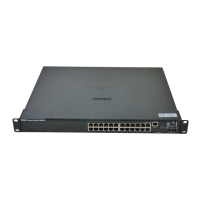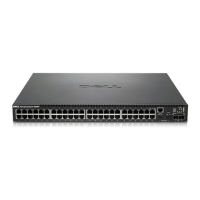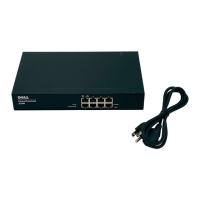l Type — Specifies the type of port, indicates one of the following:
¡ 1000Base-TX — 10/100/1000Base-T RJ-45 port
¡ 1000Base-SFP — gigabit SFP transceiver port
l State — Displays the current state of the port within the Spanning Tree:
¡ No Link — No valid link on the port.
¡ Disabled — Port has been disabled by the user or has failed diagnostics.
¡ Blocking — Port receives Spanning Tree configuration messages, but does not forward packets.
¡ Listening — Port leaves blocking state due to topology change, starts transmitting configuration messages, but does not forward packets.
¡ Learning — Port has transmitted configuration messages for an interval set by the Forward Delay parameter without receiving contradictory
information. The port address table is cleared, and the port begins learning addresses.
¡ Forwarding — Port forwards packets and continues learning addresses.
l Trunk — Indicates whether the port is configured as a trunk member
The Port Settings page also contains the following editable fields:
l Priority — Indicates the priority assigned to the port for the Spanning Tree Protocol (0 to 255). A port with a higher priority is less likely to be blocked if
the Spanning Tree Protocol detects network loops. Low numeric value indicates a high priority.
l Path Cost — Specifies the cost assigned to this port for the Spanning Tree Protocol (1 to 65535). A port with a lower cost is less likely to be blocked if
the Spanning Tree Protocol detects network loops.
l Fast Link — Immediately enables the port in forwarding state when a link comes up. The port is not part of the Spanning Tree at that time, but will
participate in future Spanning Tree resolutions.
CLI Commands
The following table summarizes the equivalent CLI commands for items in the Spanning Tree/Port Settings page.
Example
Console(config)#interface ethernet 1/5
Console(config-if)#bridge-group 1 path-cost 50
Console(config-if)#bridge-group 1 priority 0
Console(config-if)#bridge-group 1 portfast
Trunk Settings
On the Trunk Settings page, you can specify Spanning Tree parameters for each trunk. For each port number listed in the Trunk column, the following fields
are available:
l Priority — Indicates the priority assigned to the trunk for the Spanning Tree Protocol (0 to 255). A trunk with a higher priority is less likely to be blocked
if the Spanning Tree Protocol detects network loops. Low numeric value indicates a high priority.
l Path Cost — Specifies the cost assigned to the trunk for the Spanning Tree Protocol (1 to 65535). A trunk with a lower cost is less likely to be blocked if
the Spanning Tree Protocol detects network loops.

